|
Focke-Wulf Fw 56 Stosser
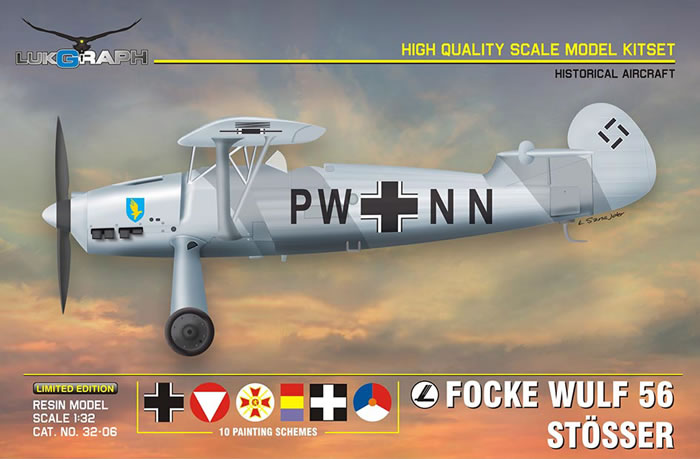
Lukgraph, 1/32 scale
S u m m a r y : |
Catalogue Number: |
Lukgraph Kit No. 32-06 - Focke-Wulf Fw 56 Stösser |
Scale: |
1/32 |
Contents & Media: |
120 parts in grey resin; 16 photo-etched parts; acetate film; decals. |
Price: |
Email Lukgraph for purchase and pricing enquiries |
Review Type: |
First Look |
Advantages: |
Excellent casting; high level of detail; straghtforward parts breakdown. |
Disadvantages: |
None noted. |
Conclusion: |
Highly Recommended. |
Reviewed by
James Hatch

Kitty Hawk's 1/32 scale OS2U Kingfisher
will be available online from Squadron.com
The Focke Wulf Fw 56 Stösser (Goshawk) was a single-engine, high-wing monoplane advanced trainer, built in the 1930s in Germany.t was developed, in accordance with a request by the Reich Air Ministry for an advanced fighter trainer, by Kurt Tank, chief engineer with Focke-Wulf. It was also considered for possible use as a home defence fighter. The first prototype flew for the first time in November 1933. A second prototype had some modifications made to the fuselage, and metal rather than wooden wings for flight testing. The third prototype, which flew in February 1934, reverted to the wooden wing and satisfied the technical designers. After comparison flights in 1935 against its two competitors - the Arado Ar 76 and the Heinkel He 74 - the Air Ministry ordered production to begin. A few were sold for private use, for instance to Gerd Achgelis, who later founded the helicopter company Focke-Achgelis with Henrich Focke. Ernst Udet, an advocate of the use of dive bombers, tested the second prototype - Fw 56 V2 - in this role, and on his recommendation the development of dive bombers was given greater attention.
The Fw 56 was a high-wing aircraft with a fuselage of steel tubes, clad in metal at the front, and canvas elsewhere. The wing was of wood, clad mostly in plywood, while the trailing edge was covered with fabric. The three-point undercarriage was fixed and possessed a tail skid. Although only 1000 were built, the Fw 56 had numerous operators, including Spain, Romania, Bulgaria, Austria, The Netherlands, and of course her native Germany. (Wikipedia)
Lukgraph
Lukgraph is a relatively new company on the resin kit scene, and this is only their sixth 1:32 release. This is one model kit that I’m certainly happy to see, and in my preferred 1:32 scale, having got a liking for the subject when I built the old 1:72 Heller kit several decades ago. As far as I know, this is the first venture into this subject, in this scale, from any manufacturer, and it’s been a long time coming! Thank you Lukgraph. The kit itself is packaged into a quite small box, but this is the beauty of resin kits and no large sprues. Presentation is clean, simple and effective, with a Luftwaffe profile adorning the glossy-printed lid, and various national emblems showing that those countries will be represented with the available schemes. Unlike many 1:32 kits, this one actually has no less than TEN schemes to choose from, and we’ll look at those later in this article.
The information given on the Lukgraph website, gives these credentials for this release:
Material: Grey resin
Parts: 120 pcs.
Etched parts: 16 pcs.
Decals: over 100 pcs.
Film: 1 pcs.
Color manual
Model dimensions: (Length) 237,5 mm x (Span) 328 mm
Inside the box, the resin components are protected by a sheet of bubblewrap, carefully wrapping around all parts. Within, the resin fuselage and engine cowl are dry-assembled with some nifty Lukgraph-printed tape pieces, and there are two zip-lock wallets. One of these contains the wing, aileron and wing connection parts, whilst the other holds the rest of the parts, neatly bagged into smaller re-sealable wallets. Decals are printed over two sheets and a narrow strip, protected by a plastic sleeve, and a single fret of PE parts is placed in a small packet along with a self-adhesive sticker for the instrument panel (to fit behind the PE fascia), and some small pieces of acetate for the windscreen. An attractive, colour-printed manual completes the contents….well, almost. Included in this pack are two of the schemes, printed on a high quality vellum-style paper, and each of them is personally dedicated to me! That really is a personal touch that I’ve never seen in any other kit release, ever. Okay, onto the parts:
Fuselage
External detail shows the forward metal plating and rear fabric texture very well. Panel line engraving is very good, with only the line separating the plating from the fabric, perhaps being a little shallow and in need of a quick re-scribe. A couple of other panel lines would benefit too.

A little filling and re-scribe will be needed on one of the engine cowl panel lines, as it seems to go a little wonky in one spot. Again, a simple fix that shouldn’t tax anyone with the skills to build a resin kit. The subtleness of the fabric and rib effect looks correct to any photos you may Google of this machine. A few minor scratches, possibly on the masters, will need a small touch of filler to fix. In all though, a very nice representation, and with lines that look perfectly captured. Where the undercarriage and wing support struts fit, indents are cast, with a central spot that will need drilling out in order to plug in those parts. Internally, the cockpit walls have their former and stringer detail cleanly cast, with indents for locating the rear corners of the cockpit tub.

All parts here are cleaned up and ready to assembly. You will need to use a little putty along the lower fuse seam, where the casting block has been removed. This isn’t uncommon with resin kits.
Wings
I have to say that these are most impressive. The forward edge and top central panels of the real machine, were plywood covered, with only the rear third being fabric. This looks perfect to me, with the rib detail being perfectly subtle. Even panel lines distinguish the plywood sheeting panels and demarcation from the fabric areas. Sometimes, it’s the little things that mean a lot, and here, the pips onto which the ailerons hang, line up with the small protruding hinge covers on the upper surface. This means that when you pop the ailerons into position, the very slight intentional gap at the leading edge, portrays those pips as being the actual connections points. Those ailerons also fit perfectly.

To reinforce the wings, they are cast with a steel rod running through them. That also doubles as a connecting point on the central block, along with two resin pips. That block will need drilling out at that point, and the steel pins themselves may need shortening by around 1mm so they don’t clash. A fine rub down with a sanding sponge will finish the sheeted areas of the wing off nicely, prior to priming. All parts have casting blocks removed, and you’ll just need to do some remedial clean-up where they used to fit, such as the minor edge that runs down the forward wing leading edge.
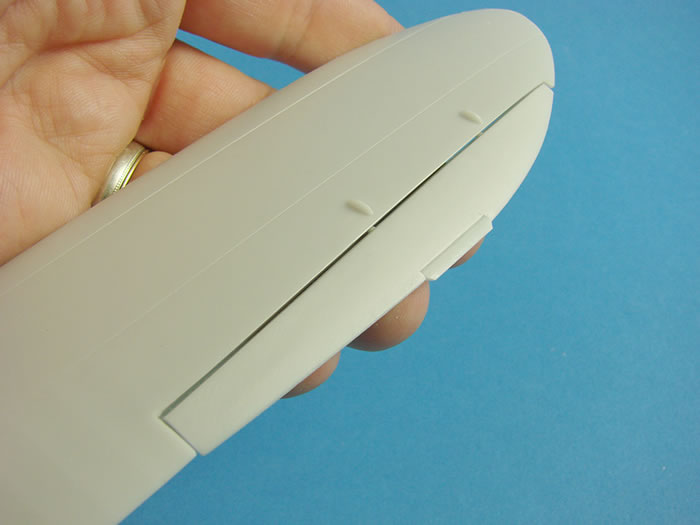
From here on, it’s easier to look at what the kit offers in terms of detail and show the resin parts accordingly.
Cockpit
Typically, construction starts here, and the model is built around a tubular framework tub. Each side is cast as a single piece that will need minimal clean-up.
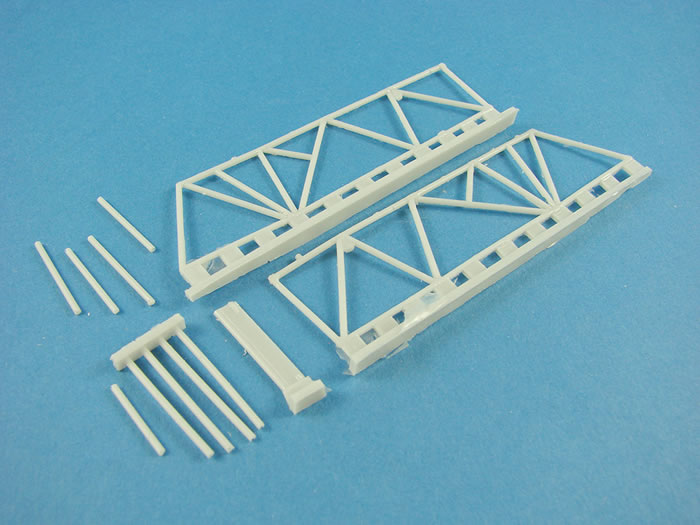
A castellated casting block is the biggest obstacle to tackle, but a razor saw will make short work of it. The spacers dividing the sidewalls are cast onto a block, and the manual gives the specific lengths for these at every connecting point. A nicely cast cockpit floor with tread boards then sits into this, and the pilot seat position is clean and unambiguous. A casting block will need to be removed from the latter, and a set of PE seatbelts is included to furnish this. As mentioned, the instrument panel is a multi-layer affair, and this is sat atop a rectangular PE board with yet more neatly etched details.
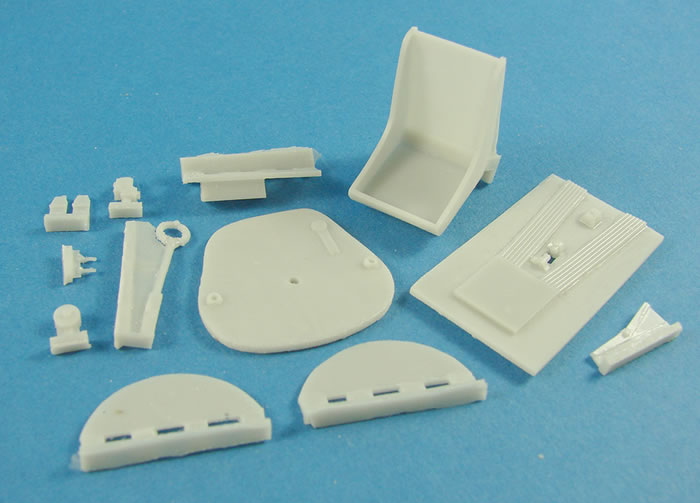
The Fw 56 cockpit was still quite a simple affair, but one I feel is certainly more than adequately portrayed here by Lukgraph.
Engine
Yes, unlike many resin models that feature inline engines, this one has the complete Argus As 10C engine that you can display with the engine cowl removed.
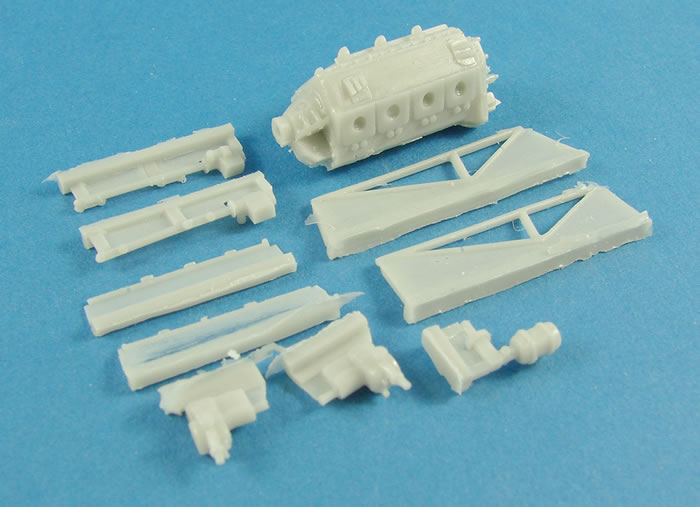
As the lines of the Stösser are so beautiful, I will really have to tear myself to be able to break them to reveal this nicely reproduced engine. First World problems! The As 10C is comprised of a series of both resin and PE parts, with the engine block being separate to the eight cylinders and individual conn rods, magnetos and ignition conduits.
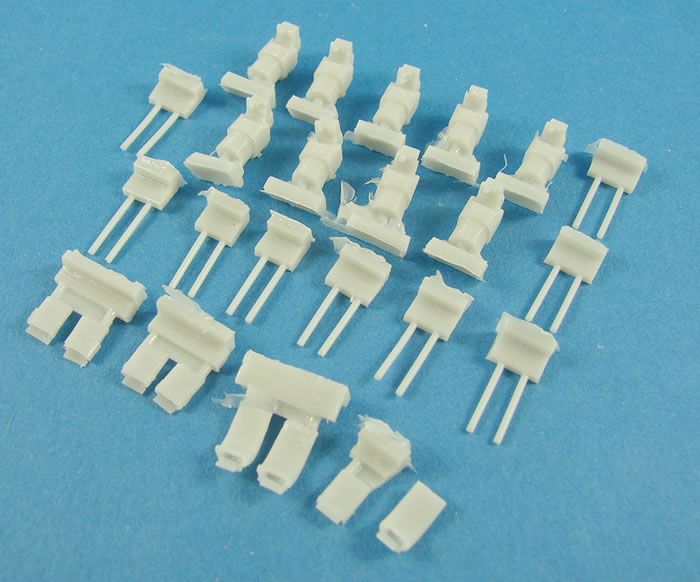
A note is given in the manual to add the ignition leads yourself, if required, using lead wire. The parts are beautifully cast, along with engine bearers and a detailed firewall. A forward engine cowl completes the ensemble, flawlessly cast and with some nice detail. Two propellers are included, one with spinner and one without.
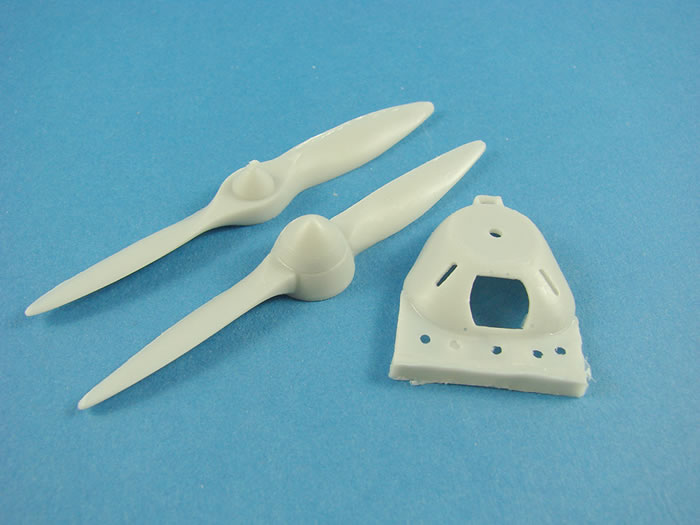
Exhaust stubs are individual too, and the ends are hollow cast.
Struts
Here I’ll look at all struts, be it the undercarriage or the wing support items. These are cast with what appears to be a brass reinforcement rod running through them, and they are well-cast, with no breakout of the metal, despite it looking so on the thin parts. Holding them to the light shows that the metal rods are fully encapsulated.
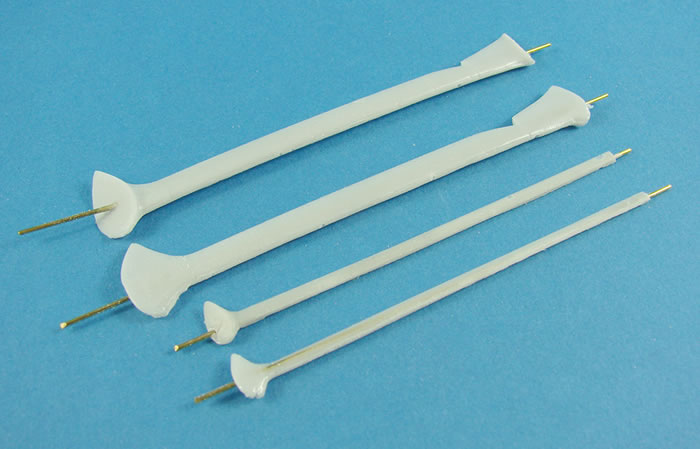
There are two main struts per wing side, and some small sub-struts that run between the main struts and the wing. Cabane struts join the fuselage directly to the wing, and you will need to open up the wing and fuselage locating points before assembly.
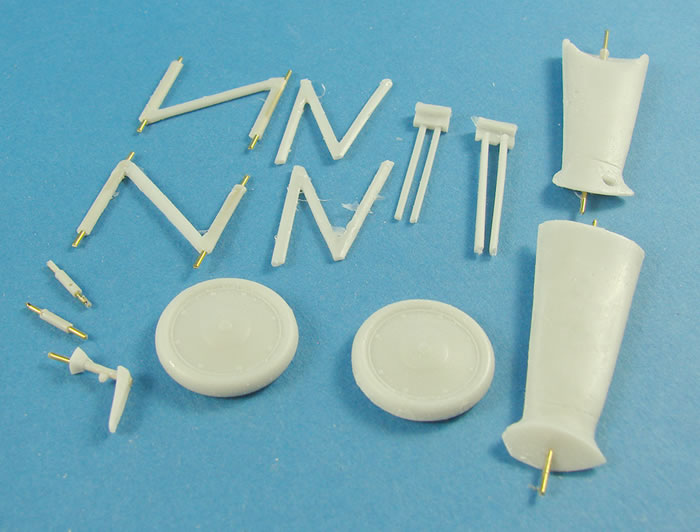
The undercarriage struts are quite wide but also thin, with reinforcement rods cast in situ. These will need to be bent at point of exit, and then cut to length to suit the connection to the fuselage and wheels. As with many parts in this kit, the wheels are removed from their casting blocks and simply require a little clean-up before use.
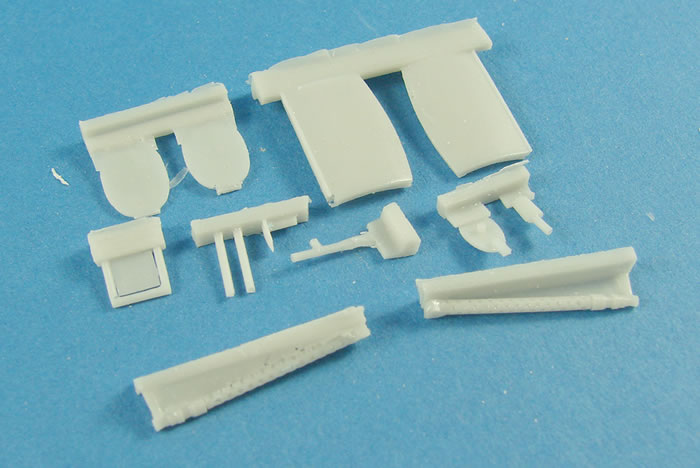
Tail Surfaces
These are popped into a single bag, and need minimal work on them before they can be used. One pip is missing from my stabiliser, for mounting the elevator. This can easily be replaced with wire. Elevators and rudder display that subtle fabric and rib finish, and the stabiliser is plywood skinned. This part fits to the fuselage via two locating pips. I did try to fit these and the curve on the fuselage area is too pronounced for the stabiliser, and there is a gap between the two. As sanding the connecting fuselage face would elongate the joint, I suggest that something like Magic Sculp is added to the fuselage joint area, and a wetted stabiliser is temporarily added to achieve the correct profile.
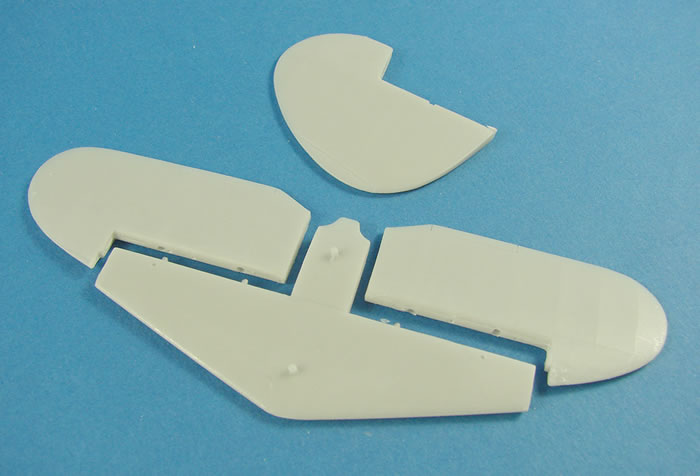
All resin is nicely cast, and with a precision that I like to see, a’la ailerons and fuselage fit etc. and most casting block removal and clean-up is done for you, with only a razor saw needing to remove the rest, and a sanding stick/sponge for the remainder of parts. There are a few bubbles here and there, but none have broken the surface , so cause no issue at all.
Photo Etch & Instrument Foil
Here we have engine parts, seatbelts, two instrument panel fascias and numerous other small details. These are etched onto a thin sheet of plain brass, and connection tabs are nice and thin. Detail itself is as good as from any other contemporary manufacturer.
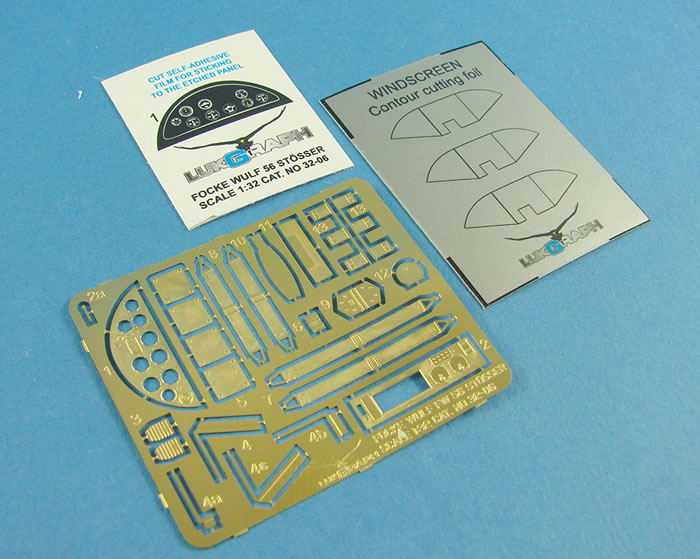
The inclusion of a coloured sticker for the instrument panel is actually quite smart. Any problem with alignment, and you can unpeel it and correctly replace. It’s glossy so you don’t need any acetate either. Instrument definition is also spot-on.
Decals
These simply look perfect, and akin to the sort of decals I’d expect in an Eduard kit. Not only are they amazingly thin, but they also have minimal carrier film. Colours are solid with the white not being too vivid, and the other colours look authentic. The only thing I can criticise is a lack of stencils, assuming the Fw 56 was adorned with them. You might need to raid your spares drawer for that. Swastikas are supplied as halves, in the conventional way that gets around the draconian laws of countries such as Germany.

The schemes represented here are:
Fw 56 Stösser, G1+43, Hungarian Air Force
Fw 56 Stösser, G-129, Hungarian Air Force
Fw 56 Stösser, G.126, Hungarian Air Force
Fw 56 Stösser, C-I, Spanish Republican Air Force
Fw 56 Stösser, 11, Bulgarian Air Force
Fw 56 Stösser, LSK III, Dutch Air Force
Fw 56 Stösser, 102, Austrian Air Force
Fw 56 Stösser, PM+AP, Luftwaffe
Fw 56 Stösser, NN+AA, Luftwaffe
Fw 56 Stösser, PW+NN, Luftwaffe
Instruction Manual
A glossy and attractive 20-page publication that has the box art and history of the Fw 56 on its cover. Inside, the constructional stages are illustrated by means of shaded line drawings that look easy enough to follow. Where necessary, colour labels are attached to the parts for painting, and PE parts are illustrated by means of yellow part labels. There is a little rigging on the struts, but nothing to be alarmed about. I reckon you could rig this in 30 minutes! The remainder of the manual is given over to the ten colour schemes, with nicely rendered side profile, and simplistic upper and lower profiles. Paint codes aren’t given, but are instead simply ‘named’. Please do your reference here.
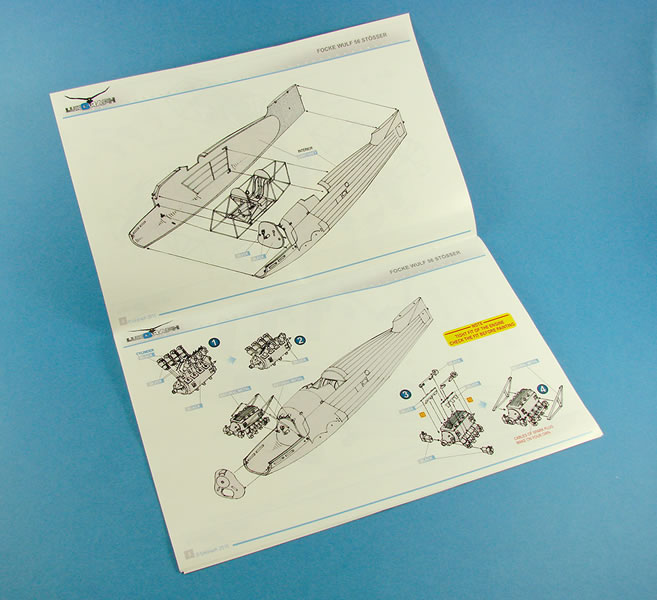
And here are the rather nifty personalised cards that were included with this kit. One of them is also of a scheme I intend to build for Military Illustrated Modeller.
I really do worry about future years, as all the models I wish I had the chance to see are being released over such a short time! No, I’m not complaining at all, and I feel honoured to be given the chance to look at one of those kits I always hoped I would see.
Lukgraph has done a wonderful job of recreating the lines of this parasol-wing trainer aircraft, and crammed in just the right amount of detail. Construction looks very straightforward and I dare say that this is a model that could be made by someone who has worked with resin before, but relishes a chance to build a full model. Such a variety of schemes is also a clincher!
Highly Recommended
My sincere thanks to Lukgraph for the opportunity to review this release. To purchase directly, check out your online hobby store, or email Lukgraph HERE.
Review Text Copyright © 2016 by James Hatch
Page Created 6 June, 2016
Last updated
6 June, 2016
Back to HyperScale Main Page
Back to Reviews Page

|
